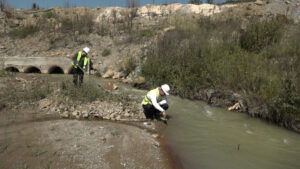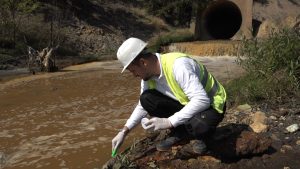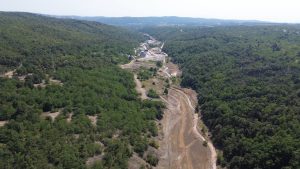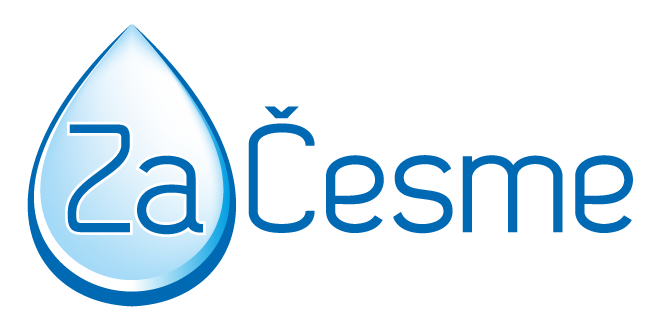
01/11/2023
Pollution of watercourses and sediments with heavy metals
From September 4th to 9th, 2023, the third sampling of water, sediments and ichthyofauna was carried out on the rivers in Bor and Zaječar districts, as part of the project “Environmental response to mining expansion in Timočka Krajina” funded by the EU and implemented by the Association “Za Drinking Fountains” with partner organizations from Bor and Zaječar.
Based on the results of laboratory tests that were conducted to assess the impact of mining activities on the water quality of the Black Timok, the Great Timok, the Borska River, the Brestovačka River and the Pek, in the conclusion of the reference laboratory from Belgrade, which was engaged in this work, it is stated that these rivers in the Timočka Krajina are affected by pollution, both of the watercourses themselves and of the sediments and ichthyofauna, as reported by Boban Pogarčić from the Association „Za Drinking Fountains“.
In order to determine the potential pollution of the Pek River and the rivers from which it originates, samples were collected at 18 locations: By analyzing these samples, the laboratory experts concluded the following: A water sample of the Little (Mali) Pek River, taken before the entrance to the sewage system, showed no signs of pollution. However, downstream, after passing through the open pit area, an increase in iron, manganese and sulfate levels was observed in the water sample. Also, the concentration of copper in the sample increased after surface
mining, which indicates the need for continuous monitoring of this parameter. As for the Great (Veliki) Pek River, the values obtained for the analyzed parameters generally fit into the higher qualitative categories observed in the samples.
In conclusion, the analysis confirms that, in accordance with the current regulations, there is a certain level of pollution that exceeds the criteria for the classification of the Peck River, which belongs to Class III. In particular, an increased concentration of sulfate, iron, manganese and aerobic heterotrophic bacteria was observed.

Regarding the examination of sediment samples at the mentioned locations, the analysis showed that in the sediment samples of the Little (Mali) Pek River, before the Majdanpek area, metal concentrations did not exceed the values that require remediation. However, entering this area, especially downstream of the mining area, these concentrations exceeded remediation values. Additionally, arsenic and zinc concentrations exceeded remediation values in most samples in the area.
After the territory of the municipality of Majdanpek, watercourses were sampled at 32 locations in the territory of Bor and Zaječar. Analysis of a surface water sample of the Brestovačka River, taken outside the potentially polluted area, did not reveal any signs of pollution. However, it is important to say that on the first day of sampling, it rained lightly, as noted in the laboratory Report that performed the sampling.
Furthermore, when testing water samples from the Brestovačka River after the entering of the waste channel from the Čukaru Peki mine, it was noticed that certain parameter values showed a slight increase compared to the values recorded at the location before the entry of waste water. Also, the analysis of water samples from the Black Timok River, after entering the Brestovačka River, indicated a slight increase in the concentrations of the analyzed parameters. However, during the evaluation of sediment samples from the waste channel of the Čukaru Peki mine, the Brestovačka River immediately after the entry of wastewater from the mine, and the Brestovačka River before its merging with the Black Timok River, an increased concentration of copper was detected which exceed the remediation values.
The further course of the Black Timok River is classified as Class II and, for the most part, maintains this classification up to the point where it meets the Borska River. The surface water of the Borska River, from Bor to its confluence with the Black Timok, belongs to the category of
poor quality and is marked as Class IV. Immediately downstream of the mine near Bor, sediment samples showed metal concentrations exceeding remediation requirements for copper, arsenic, cadmium, zinc and nickel. Also, the analysis of water samples showed an increased concentration of sulfate. The water samples had an orange-yellow color.
Based on the analysis of water samples before and after the direct confluence of the Borska River into the Great (Veliki) Timok, it can be concluded that the arrival of the Borska River leads to an increase in the concentration of certain metals both in the water and in the sediment. The most significant changes observed in the water samples were in the concentrations of copper, iron and manganese.
As the Timok River continues its course towards the Danube, concentrations of metals such as copper, arsenic, cadmium, nickel and zinc have been observed. The presence of these metals is not negligible, which highlights the need for continuous monitoring of the water and sediment quality of the Timok River and its tributaries, according to the conclusion of the reference laboratory that performed the sampling and analysis of the taken material.

The fish samples that were analyzed were caught in the Timok River – below the Sokolovica dam, as well as in the Brestovačka River near Metovnica. In a sample of fish from the Brestovačka River, the concentration of cadmium exceeds the maximum allowed concentration. The concentration of the other analyzed metals does not exceed the maximum allowed concentrations for the parameters whose values are defined by the Rulebook.
By May 2024, when the project ends, another sampling will be done at the same locations. All the previous ones, as well as the results of this third measurement, are published on the website ekoloskiodgovor.rs in the database section.
Association “Za Drinking Fountains”
This text was produced within the project “Environmental response to mining expansion in Timočka Krajina” funded by the European Union, and implemented by the Association “Za Drinking Fountains”, the Association of Young Researchers Bor, Civic Library “Europe” Bor and Children’s Center Zaječar. The content of the text is entirely responsibility of these associations and do not necessarily reflect the views of the European Union.


